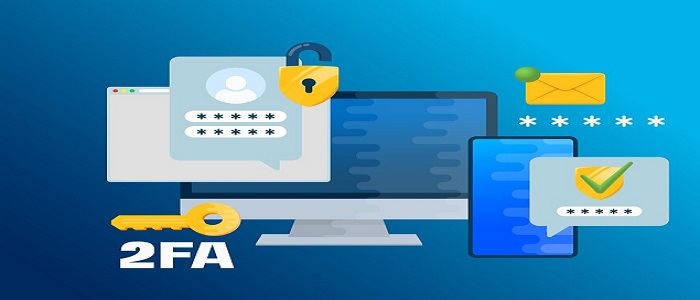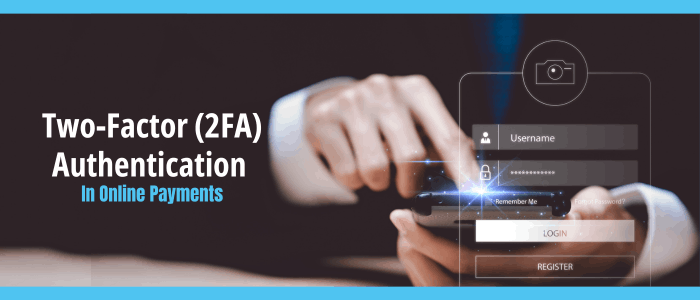In this digitally advanced world, where everything is just a few clicks away, online payments have become an integral part of our daily lives. From ordering groceries to booking flights, the convenience of making transactions from the comfort of our homes is unparalleled. However, with this convenience comes a lurking threat – cybercriminals who are eager to get their hands on your personal and financial information. It’s a digital battlefield, and the good guys wear a cape – Two-Factor Authentication (2FA).
In this blog, we’ll delve deep into the world of 2FA and explore its key role in safeguarding online payments. So, buckle up as we take you through the journey of how Two-Factor Authentication, like a trusty assistant, stands by your side to protect your digital defense.
Understanding Two-Factor Authentication (2FA):
Two-factor authentication is like the secret handshake of the digital world. It’s a security process that goes beyond the traditional password. In Two-Factor Authentication, a user needs to provide two distinct authentication factors to verify their identity. These factors typically fall into three categories:
1. Something You Know: This includes passwords or PINs, the digital keys to your online kingdom.
2. Something You Have: Think of this as your digital keys, like a smartphone or a physical token that generates time-sensitive codes.
3. Something You Are: These are biometrics, like your fingerprint or your retina scan. You must provide at least two of these factors to gain access or complete a transaction. It’s like needing both a map and a compass to navigate the digital jungle, ensuring that your online presence is secure.
The Importance of Secure Online Payments:
Online payments have become the lifeblood of e-commerce, flowing through the digital lanes of the modern world. Whether it’s ordering groceries, booking vacations, or treating yourself to the latest gadgets, financial transactions have migrated from brick-and-mortar stores to virtual checkout counters. The convenience of swiping, clicking, or tapping your way to purchases has transformed the way we shop and manage our finances.
But, like any thriving metropolis, the digital landscape of online payments has its underbelly of potential threats. There, in the shadows, lurk cybercriminals who are constantly developing new and innovative ways to exploit vulnerabilities in the online payment ecosystem. These threats come in various forms:
-Fraud: Malicious actors often use stolen credit card information to make unauthorized transactions, leaving victims in a financial bind and merchants at a loss.
-Data Breaches: Hacking into the databases of online retailers or financial institutions is an all-too-common occurrence. When these breaches happen, sensitive customer data like credit card numbers, email addresses, and passwords fall into the wrong hands.
-Identity Theft: Online criminals can use stolen information to impersonate individuals, open accounts in their names, or commit other fraudulent activities. The fallout can be financially and emotionally devastating.
In this age, where our financial information is more accessible than ever before, safeguarding it is not just prudent; it’s imperative. This is where our trusty assistant, Two-Factor Authentication (2FA), steps in as your digital bodyguard. With Two-Factor Authentication, your online payments are not just a matter of convenience but a matter of security. It acts as an additional layer of protection, ensuring that even if cybercriminals manage to breach one barrier, they still need to overcome another, more stringent obstacle.
How Two-Factor Authentication Enhances Online Payment Security:
Imagine you’re about to make an online payment. You enter your credit card details, but that’s not the end of the story. 2FA steps in and demands that you provide another layer of verification, such as a one-time code sent to your smartphone or generated by a dedicated app.
This additional step acts as a digital gatekeeper, ensuring that even if a cybercriminal gets hold of your card details, they can’t proceed without the “second key.” It’s like having a vault with two locks instead of one, an extra layer of security that shields your financial data from prying eyes.
Implementing Two-Factor Authentication for Online Payments:
The implementation of Two-Factor Authentication is like adding an extra layer to your digital defense. It’s simple, and many online payment platforms and services already offer 2FA as an option. You typically link your phone number or use an authentication app that generates those time-sensitive codes to enable it.
These codes are required in addition to your password when you log in or make a payment. By doing this, you’re giving your digital bodyguard an additional tool to protect your online transactions.

Addressing Common Challenges and Concerns:
While Two-Factor Authentication (2FA) stands as a heroic defender against the risks of cyber threats, its implementation is not without its own set of hurdles. Despite recognizing its necessity, users often find themselves contending with concerns and challenges, fearing that this added layer of security might be more of a hurdle than a help. Let’s delve into these common apprehensions and how they are being addressed:
-User Experience: The first and foremost concern is how 2FA might affect the user experience. Users are wary that the extra step might be unmanageable and slow down their online activities. After all, in a world where speed and efficiency are paramount, any interruption, no matter how brief, can be a cause for concern.
However, the good news is that many organizations have recognized this apprehension and are actively working to streamline the 2FA process. By doing so, they aim to make it more user-friendly and less intrusive. For instance, some services provide the option for users to stay logged in for a certain period, reducing the frequency of additional verifications.
-Compatibility Issues: Users also fear that 2FA might only be supported by some of their favorite apps and websites. This can lead to a fragmented user experience where some platforms require 2FA while others do not, creating a digital patchwork of security measures.
However, as awareness of the importance of Two-Factor Authentication grows, more and more platforms and services are integrating 2FA options. Compatibility issues are gradually diminishing, offering a more consistent and secure experience for users across various online platforms.
The Future of Two-Factor Authentication in Online Payments:
The future of Two-Factor Authentication in online payments is promising. As technology continues to advance, we can expect even more secure and user-friendly methods of verification. While traditional methods of 2FA, like one-time codes, remain dominant, biometrics are making their way into the scene. Facial recognition and voice authentication are becoming more widely used, providing a seamless and secure experience for users. It’s like upgrading from a secret handshake to a high-tech retina scan, ensuring that your online payments remain secure.
Security is paramount in a world where online payments have become as routine as your morning coffee. Two-factor authentication is the digital guardian that ensures your financial data remains safe and your online transactions are secure. Whether you’re splurging on your favorite online store or paying your monthly bills, 2FA stands by your side like a trusty helper, making sure your digital fortress remains impassable.
So, as you continue your digital shopping spree or pay your essential bills online, remember that the dynamic duo – you and Two-Factor Authentication – are working together to keep your financial data safe. It’s like having a digital bodyguard, ensuring your digital world remains secure and your virtual cape never loses its shine.

